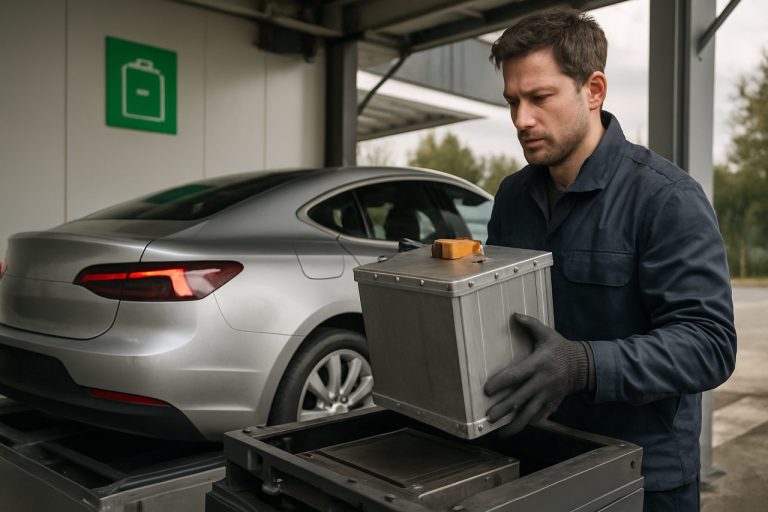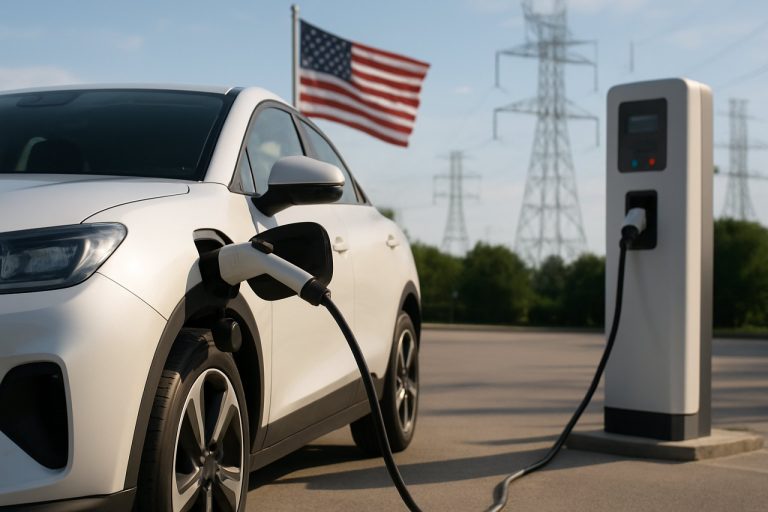
- America’s electric vehicle (EV) future is at risk due to stalled federal incentives for EV charging infrastructure, threatening clean energy progress and job creation.
- Uncertainty in U.S. policy leads automakers to hesitate on investments, raising concerns about a potential loss of technological and industrial leadership.
- China advances rapidly in the global EV market with affordable, efficient cars, challenging American automakers despite trade barriers.
- Stalled infrastructure expansion could leave many regions as “charging deserts,” slowing EV adoption and innovation across the nation.
- Historic federal interventions, like rural electrification, show bold action can transform society—today’s EV transition demands similar ambition and collective resolve.
- The fight for EV leadership directly impacts climate action, American jobs, and future prosperity, underscoring the urgency for decisive, unified action.
Silence stretched across the sweeping highways and rural byways of America’s heartland—not the silence of peace, but the charged hum of possibility abruptly stalled. For more than a century, oil and gasoline have fueled the nation’s relentless momentum, leaving the earliest electric vehicles discarded on the historical shoulder. Now, the next act in this long-running drama of power, industry, and innovation unfolds, with the electric car at its heart, once again under threat.
Yesterday’s horse-drawn carriages gave way to Model Ts, as electric coupes languished in the shadows of oil’s prosperity. Few could have imagined the billowing clouds of emissions that would come to define a century, or the wrenching implications of climate change that now haunt every decision. The argument, once decided in smoky backrooms and sunbaked oil fields, roars anew in Washington’s corridors and the court of public opinion.
In today’s high-stakes maneuvering, the fate of electric vehicles is tightly wound with American jobs, technological leadership, and the health of the planet. Actions to halt the federal incentive for building EV charging stations don’t just slow the march of progress—they threaten entire industries. This isn’t merely about which vehicles fill the highways; it’s about which flags fly on tomorrow’s factories, and who reaps the rewards in a rapidly electrifying world.
Initial momentum promised a revolution: billions earmarked to blanket rural highways and urban neighborhoods with charging stations, bridging the gap between ambition and adoption. That promise now flickers. Legislative challenges and executive maneuvers cast doubt on whether the nation can capably shift from fossil fuel dependence to a cleaner, more self-reliant future. Political whiplash and partisan power plays carve uncertainty into corporate balance sheets, with automakers hesitating on investments and workers wondering if another industrial exodus is at hand.
Across the Pacific, the gears of change have already spun. China’s manufacturers—agile, bold, and state-supported—deploy fleets of affordable, efficient EVs that undercut American alternatives even with tariffs towering overhead. A $10,000 electric car from BYD now commands global attention, edging closer to U.S. shores, challenging not just Detroit, but the very idea of American industrial leadership.
Stalled infrastructure exacerbates the risk. In the clean, wire-laced future that policymakers envision, charging your car should be as natural as dialing up a playlist on your phone. But without federal resolve and vision, vast swaths of the country will remain charging deserts—consumer anxieties growing, investments shrinking, innovation stifled. Such hesitation gives rivals room to surge past.
This isn’t the first time Washington has had to bridge a technological divide. The echoes of rural electrification in the 1930s, championed by practical visionaries who saw the lightless, unpowered corners of Texas and Appalachia, remind us that bold intervention can transform the lives of millions. Their gamble paid off. Can the twenty-first century muster similar resolve?
The stakes stretch well beyond partisan squabbles. At risk is the kind of American future we can believe in—one where education and innovation go hand in hand, and where workers in every state help turn evolving technologies into shared prosperity. The window for action narrows by the month. For the electric car, and all it symbolizes, this isn’t simply about survival. It’s about meaningfully leading—on climate, on industry, on the promise of a healthier, more just society.
The clear message: Opportunity rarely waits. America stands at the brink of losing not just the race for the electric vehicle, but the broader contest for twenty-first-century manufacturing, jobs, and global standing. Course corrections won’t come easy, and some roads once abandoned may never reappear. This moment—difficult, urgent, and transformative—demands collective vision, the kind that once illuminated the nation, mile by electrified mile.
America’s EV Crossroads: Will the U.S. Lose the Race for the Electric Car Revolution?
America’s Electric Vehicle Revolution: Facts, Trends, and Urgent Questions Answered
Key Additional Facts & Insights
1. EV Adoption Rates & Market Trends
– As of Q1 2024, electric vehicles (EVs) represent roughly 7-8% of new car sales in the United States, according to the International Energy Agency (IEA).
– China now leads in EV production and adoption—more than 60% of global EVs are on Chinese roads (IEA).
– In Europe, EV adoption rates are higher than in the U.S., driven by stricter emissions regulations and well-funded charging infrastructure.
2. Charging Infrastructure: Lagging Reality
– The U.S. currently has around 160,000 public chargers (as of 2023, per Department of Energy), compared to over 1 million in China.
– Rural communities and interstate routes remain especially underserved, creating “charging deserts” that deter consumers from switching to EVs.
# How-To Steps: Finding a Charging Station
1. Use charging apps like PlugShare or ChargePoint to locate nearby stations.
2. Check for fast-charging capabilities (Level 3) versus slower options (Level 2).
3. Plan long trips in advance by mapping charging stops.
4. Consider at-home installation (Level 2 charger) if possible—costs run $500-$2,000.
3. Affordability: The BYD Challenge
– Chinese manufacturer BYD (Build Your Dreams) now offers EVs priced as low as $10,000—the Seagull model stoked global headlines in early 2024.
– Typical U.S. EVs still carry significant markup, though models like the Chevy Bolt ($26,500 base price) and Nissan Leaf ($29,000 base price) signal falling costs.
# Reviews & Comparisons: BYD vs. U.S. EVs
– BYD Seagull: ~190-mile range, basic tech, ultra-affordable.
– Chevy Bolt EV: ~260-mile range, more robust features, higher safety ratings.
– Tesla Model 3: ~272-mile range (base), premium features, highest charging network coverage.
4. Job Market Shifts & Industry Forecasts
– The EV revolution could create up to 150,000 new U.S. jobs by 2030 (Jobs Move to America Act estimates), but also threatens traditional auto manufacturing positions tied to combustion engines.
– Gigafactories (like those by Tesla and Ford) are central to securing domestic battery supply and advanced manufacturing jobs.
5. Global Industry Leadership & Security
– Raw material sourcing (lithium, cobalt, nickel) is a risk: China dominates mining and refining, a point of national security concern for the U.S. (U.S. Department of Energy).
– New U.S. and EU incentives are designed to localize battery manufacturing, but these efforts lag Asia’s scale and expertise.
6. Policy and Regulation
– Federal incentives: The 2022 Inflation Reduction Act earmarked $7.5B for EV charging, but less than 10% has reached projects due to bureaucratic slowdown and state disagreements.
– Shifting standards and political uncertainty can make it difficult for automakers to commit to long-term EV investments.
Controversies & Limitations
Range Anxiety
– The average U.S. EV range now exceeds 250 miles, but cold weather, high speeds, and battery aging can reduce practical range by 20-40%.
– Standardized, user-friendly charging networks are needed to calm consumer concerns.
Environmental Footprint
– Battery production is energy-intensive and can have significant local environmental impacts, particularly in mining hotspots.
– End-of-life recycling programs are emerging (e.g., Redwood Materials, Li-Cycle), but battery recycling is still in early stages.
Pros & Cons Overview
Pros:
– Lower operating/maintenance costs vs. gasoline vehicles.
– Zero tailpipe emissions; improved urban air quality.
– Quieter driving experience and instant torque/performance.
Cons:
– Higher upfront costs (except with strong incentives or used market deals).
– Incomplete charging network, especially outside urban centers.
– Issues sourcing critical minerals sustainably.
Pressing Reader Questions—Answered
Q: Will the U.S. run out of electricity if EV adoption spikes?
A: No, grid capacity is manageable with careful planning. Most charging happens at night when demand is low, and utilities are investing in grid upgrades, smart charging, and renewables.
Q: Are used EVs a good buy?
A: Used EVs can offer excellent value, but check battery health and warranty status. Most modern EV batteries retain 70-80% capacity after 8 years or 100,000 miles.
Q: How much does it cost to charge at home?
A: Typically $10-$15 for a full charge, comparable to paying $1.00/gallon for gasoline. Costs depend on local electricity rates.
Q: What if I live in an apartment?
A: Options include shared community chargers (increasingly required in new construction), workplace charging, or portable chargers that plug into regular outlets.
Actionable Quick Tips for Consumers
– Check incentives: Use tools like the Department of Energy’s “Alternative Fuel Data Center” to find federal/state EV and charger rebates.
– Subscribe to charging networks: Consider memberships for major networks if you commute or road-trip frequently.
– Test-drive multiple EVs: Compare not just price or range, but comfort, infotainment, and real-world range.
– Plan ahead for home charging: Availability and electrical capacity should factor into your vehicle choice.
– Stay informed: Follow sites like Automotive News and U.S. Department of Energy for up-to-date developments in incentives and regulations.
Conclusion: What America Must Do Now
The U.S. sits at a critical juncture. To remain a global automotive leader, the nation must:
1. Accelerate charging infrastructure investment, especially in rural and underserved communities.
2. Provide consistent federal policy—including incentives that are predictable and accessible.
3. Double down on workforce retraining and domestic battery production.
4. Foster public-private partnerships to ensure rapid response to global competitors.
Final Thought: The world won’t wait for American leadership. Each delayed investment, each wavering policy, cedes advantage to rivals. The opportunity for the U.S. to shape the clean transportation future—creating jobs, innovation, and broad prosperity—is still open, but action must be swift, decisive, and visionary.



